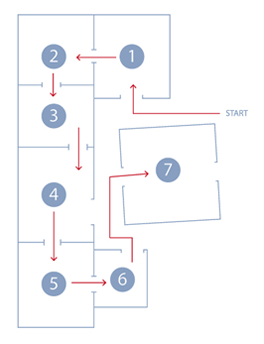In this room, Spain becomes a bit French. Let me explain:
In the year 1700, King Charles II died without producing an heir. This meant the end of the Hapsburg dynasty in Spain. Since the early 1500s, the Austrian Hapsburgs had built up a formidable empire – for more than a century Spain was the world superpower. But now, with the death of Charles II, the line was extinct.
In his will, Charles II bequeathed his properties to King Louis XIV of France, otherwise known as the "Sun King". The French King rapidly accepted them and installed his grandson Philip, Duke of Anjou, as the new King Philip V of Spain. Thus, the rule of the Kingdom of Spain was passed from the Austrian Hapsburgs to the French House of Bourbon.
The new century and the new dynasty largely picked up where the Hapsburgs had left off. Luca Giordano was still court painter when the new Bourbon King arrived. Like his predecessor Charles II, the new king spent hours watching Giordano paint. They must have seemed an odd pair: the old Italian painter watched over by an energetic, 17-year-old king, who was so different to his ineffectual predecessor.
By the mid-century, Italian painting maintained significance but shifts in taste were occurring. King Philip had been born at Versailles and, not surprisingly, he instituted French customs at the Spanish court. This included luring French artists to Madrid. There was also growing interest in the work of local artists, such as Francisco de Goya.
The eighteenth century brought in a new model for Spanish patronage of Italian artists. Previously the Spanish had imported works by Italian artists but in the eighteenth century the preferred model was to bring key artists to Madrid. This practice began with Luca Giordano and continued with Corrado Giaquinto and, later, the Tiepolos.
There are three extraordinary works in this gallery by Corrado Giaquinto, an artist who moved to Spain in 1753. His paintings feature fluid brushwork, exquisite colouring and an extraordinary sense of illusionistic depth. Giaquinto deserves to be better known in art history. His flamboyant Rococo style is comparable with that of his more famous French counterparts, François Boucher and Jean-Honoré Fragonard.
Following Giaquinto's departure from Spain in 1762, Giambattista Tiepolo and his two sons, Giandomenico and Lorenzo, were enticed to Madrid. The Tiepolos' wonderfully playful paintings exude the era's interest in "capriccio" and "fantasia" – caprice and fantasy. The Tiepolos were the last great Italian artists to work in Spain. Giambattista's death in Madrid in 1770 marked the decline of the formidable Italian influence in Spain.
The second half of the eighteenth century saw a radical change in artistic taste brought about by the influence of the Neoclassical painter and theorist Anton Raphael Mengs. When you see the drawings by Mengs, Pompeo Batoni and Donati Creti, you will immediately notice a different mood.
The Napoleonic era brought a further decline in Italian influence, especially with the end of Spanish rule on the Italian peninsula.
In 1819, the Museo del Prado opened its doors. It was home to the royal collection, now bequeathed to the people of Spain. The Museo del Prado's collection reflects the tastes of different royals. The Spanish monarchs were uninterested in an encyclopedic approach to art: rather, they indulged their tastes and monopolized the artworks of their favourite painters. Overall, the Museo del Prado's collection of Italian painting is rich and uneven in equal measure. Some artists' works are noticeably absent, while those of others – most especially Titian – are present in great numbers.
